Dell DTR Laptop Shootout - M1710 vs. E1705
by Jarred Walton on May 30, 2006 1:30 PM EST- Posted in
- Laptops
Internal Construction
Dismantling your laptop is something that may void your warranty (especially if you break something), and we don't recommend it unless you have a specific need to do so. However, we find it interesting to see how these computers are put together, so we couldn't resist the urge to "pop the hood". One thing that becomes immediately clear is that these systems are not designed to be serviced by your typical home user. Cramming this much performance into a small case requires a lot of effort, so taking apart and assembling a laptop is generally far more difficult than working with your typical desktop computer. Difficult does not mean impossible, but you will need smaller screwdrivers and you will be working in a more restricted space.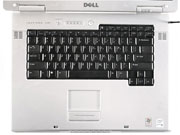 |
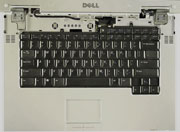 |
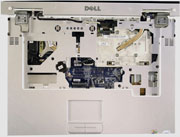 |
| Click to enlarge | ||
The first step in taking apart either of these laptops is to remove the plastic panel at the top of the keyboard area. This can be pried off using a flathead screwdriver, though you'll want to be careful that you don't scratch the finish. (Dell recommends using a plastic tool to pry this off, but we didn't have one available.) Remove a couple of screws at the top of the keyboard and you can lift it out of the way. Before you actually remove the keyboard completely, you will have to disconnect the ribbon cable. Flip up the plastic clamp and the ribbon cable can easily be removed.
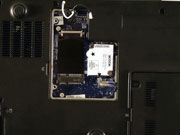 |
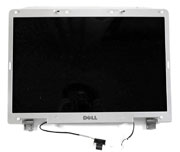 |
 |
| Click to enlarge | ||
Before you get any further into the internals, you need to remove the LCD. The first thing to do is disconnect the integrated WiFi antenna, which is found on the bottom beneath a small hatch. Color-coded wires (one black and one white) are attached to the mini-PCI WiFi card, and after prying these loose (carefully), return to the top of the system, disconnect the main display cable, and remove the four screws that hold the display panel in place.
 |
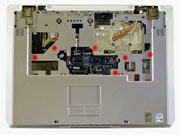 |
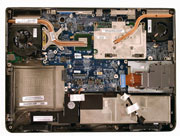 |
| Click to enlarge | ||
The final step before removing the remainder of the cover is to take out the 12 screws on the bottom of the case and six more screws on the top. There are also three cables connecting the cover to the motherboard that you will need to disconnect. Once all of the screws are removed, the plastic cover and trackpad can be removed. Plastic latches help hold the panel in place, so you will need to carefully pry the panel loose, after which you will have access to the CPU and graphics module.
In theory, it is possible to upgrade to graphics module with something faster, but you will need a Dell specific upgrade, and those are not generally available for retail purchase. You might be able to get an upgraded graphics card through Dell Spare Parts, though normally they only send out parts to replace faulty hardware. Perhaps if you have a friend with a better graphics chip that calls in for a replacement GPU....
One area that you can upgrade is the processor, which requires the removal of the heatsink, heat pipes, and fan in the top left of the system. There's not much point in performing this upgrade yourself right now, and we're also not sure how many new processors will be created that can run in these laptops. If it's possible to run Core Duo 2 (Merom) chips in these laptops in the future, that would definitely be interesting, but we have not received any official confirmation from Dell on the matter. You will definitely be able to use Core Solo/Duo chips from the Yonah family, and potentially Merom chips after a BIOS update. Whether such a BIOS update will be released or not is still a matter of speculation.










34 Comments
View All Comments
RedStar - Wednesday, May 31, 2006 - link
"NVIDIA's rating of 400 MHz does not mean manufacturers have to run it that fast"Nvidia's rating very much means the mobile part is capable of 400Mhz --anything less is an underclock.
Why on earth would nvidia publish a spec with the expectation that no one would follow it?
Heck, they could just say we have an 1000Mhz mobile core but too bad everyone will make it go 180Mhz.
Since people are running the go 7800 at 390+MHz without a power upgrade, i would have to say you are very much mistaken about the power draw.
But, i would say the primary issue was two fold.
1)Heat output (thermal profile)
2)To differentiate the product enough from Dell's similiar but ultra expensive XPS line
(of the same february time frame)
I, and others, tend to believe dell was concerned more about #2.
JarredWalton - Thursday, June 1, 2006 - link
NVIDIA wants to put the best face on its product. Just because the chip will run at 400 MHz doesn't mean it can do so within the thermal envelope a manufacturer has for a laptop. I've heard people complain about overheating issues with high-end laptops already, so if Dell plays it a bit safe I won't complain too loudly. I'd really like 1000 MHz RAM with a 333 core say over 400 core and 650-700 RAM.As for protecting the XPS line, the 7900 GS basically fills in the gap. I personally think the GF Go 7800 is going into E1705 because Dell had a bunch of extras from older XPS models. They're downclocking them to reduce power and heat. At 94W measured peak, I would certainly be concerned about long-term usage of a 90W power brick. Unless the 90W rating is conservative, but then why have a 130W for the XPS line?
Anyway, look at the battery life of the 7800 Go compared to the 7900 GTX Go, and then increase the GPU performance by 60%. If you can't have the GPU fall back to the same level (1.1 V and 100 MHz core/658 MHz RAM or something), there are good reasons to not ship a faster GPU. I *still* don't recommend the 7800 Go version, as you would be better with either more battery life (X1400) or better gaming (7900 GS). I just tested what I was sent.
RedStar - Thursday, June 1, 2006 - link
I would agree, the introduction of the 7900GS makes this moot to everyone --except those that bought the i9400 when it first came out and had only the go7800 to choose from (with no reviews yet available --except for the one that said the go 7800 was equal to the ati x1400 [we all then found out why --Dell's 260 core!!]).The limited possibility of a 7900GS upgrade sounds, at least, hopeful.
:)
Andyvan - Wednesday, May 31, 2006 - link
I bought my wife an E1705 a couple of months ago. She doesn't game, so I went with the MX1400. I also went with the slower disk, hoping that would yield lower heat/noise, and longer battery life. I'm curious as to whether I chose well.-- Andyvan
JarredWalton - Wednesday, May 31, 2006 - link
The 7200 RPM HDD kicks power draw up about 2 W when it's active versus sleeping. Really, most laptop parts are already very low power. The X1400 consumes 28W total when idle - most desktops use that much just for the motherboard. The 7200 RPM drives will run slightly warmer than the 5400 RPM models, but they are also about 30% faster in HDD performance. Adding more RAM will often make HDD performance less important, but if you copy files around on the HDD you will definitely notice the difference.Warder45 - Wednesday, May 31, 2006 - link
What about the noise difference in 5400 vs 7200? I've heard that the 7200 HD's can be a lot louder.Yianaki - Wednesday, May 31, 2006 - link
Why can't you have a top of the line 7900 GTX and when watching a DVD or the xp desktop doesn't the graphics card go into basically a sleep mode and turn of almost all the memory. HELL why don't they add a crappy additional teeny transistor space to the gpu chip if it is sooo hard to get the power requirements down on the main GPU. That way they can turn off most of the ram and the gpu and just use this additional teeny transistor space to run simple XP desktop functions or while playing DVD's. I mean a simple xp desktop functions can't take up that much die space. I simply don't get it. I mean this is like the nth graphics card from nvidia and yet it still sucks up the power. I have the horrible intel onboard graphics on my laptop and apart from it eating up some of my precious ram I am EXTREMELY happy with it doing regular desktop XP tasks. Sucks ass for gaming of course. I mean how hard is it for nvidia to totally turn off pretty much all of the GPU when just in desktop mode. Is the huge power difference just because of the high performance memory used? There really shouldn't be a penalty for getting top o' the line graphics I believe.mindless1 - Tuesday, May 30, 2006 - link
From the article,"Why would anyone want to get the X1400 in such a laptop? Obviously, because it uses far less power than even the GeForce Go 7800."
More like, most people are not gamers and of those who are, many will prefer gaming on their desktop. The % of people that will buy a laptop with gaming in mind is miniscule, and that brings up the other puzzling part about so many gaming benchmarks of laptops instead of more useful things like HDD & office productivity. Sure, anything can run office but what about working with giant databases, or wifi range, or most of the parameters that matter to most prospective laptop buyers. Gaming just isn't important at all if it were the same price. Now subtract the price difference and you see why anyone, actually most people do not pay for the gaming GPU inside.
Blahman - Wednesday, May 31, 2006 - link
Hardly... notebook sales have surpassed desktop sales recently.Desktops are on the way out if you ask me. Even if you're a gamer. There are notebooks out there already that have SLI, and the Core Duo architecture is the future of all Intel processors, and it STARTED in notebooks.
Every new notebook generation closes the performance and price gap between desktops and notebooks.
I recently configured and ordered a nice E1705 with the 7900 GS (which I really wish AnandTech had included in the benchmarks, it's more than twice as fast as the 7800 Go) for $1250 (with a $750 coupon code). Skimp on the RAM and go for a $180 aftermarket 2GB PC2-5300 upgrade.
Later on down the road you will be able to upgrade to Merom, and possibly the 7900 GTX or G80M. For now Dell is keeping their spare 7900 GTXs for warranty repairs and aren't currently for sale, but like the last generation with the 7800 GTX, it may be available in the future from Dell Spare Parts.
For tons of more info about these models check out http://www.notebookforums.com/forumdisplay.php?f=1...">the Dell 17" Notebooks section at notebookforums.com.
ElFenix - Tuesday, May 30, 2006 - link
who buys a 9 pound notebook with somewhat horrific battery life regardless unless they're gaming? an external display hooked up to a 15" or 14" 6 pound notebook would be far more useful to the user you're describing.and don't forget that this IS a gaming oriented website.